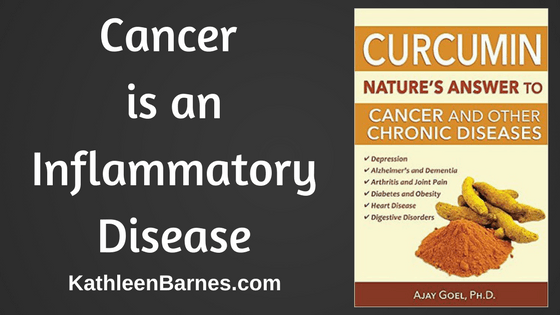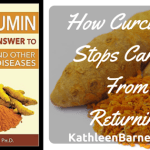From Kathleen: This is a chapter from one of the most important books I’ve published: Curcumin: Nature’s Answer to Cancer and Other Chronic Diseases by Dr. Ajay Goel, an esteemeed cancer researcher at Baylor University. This chapter explains how lifestyle choices cause most cancers and how we can prevent cancer by making wise choices.
Cancer is almost exclusively a lifestyle disease. By that, I’m not vesting blame on anyone, but I am reminding you that we all make choices about our lifestyles and that each of us can step up and make positive choices whenever possible.
You may not be able to control the off-gassing carpets and formaldehyde-laden fiberboard furniture in your office or in a public building, but you can choose what you put in your own home.
You may not be able to control whether your neighbor sprays RoundUp™ in his yard, but you can choose the types of weed control you use on your own property.
You may not be able to control the food you are served when you’re eating in restaurants, while you’re on vacation or on a business trip, but you choose what you serve in your own home.
It’s interesting that the Western world has by far the highest cancer rates. It’s also fascinating that cancer rates have skyrocketed in Japan since the 1950s, when the traditional cancer preventive diet was abandoned for the modern, Western diet with an accompanying cancer rate comparable to that in the Western world.
Common underlying cause
Cancer can be caused by any (or several) of a wide variety of things, but inflammation is definitely one of the major culprits in almost all of chronic illnesses, including cancer. Inflammation triggers a cascade of events that lead to virtually every type of cancer.
Let’s be sure we’re on the same page here:
If you’ve ever whacked your thumb with a hammer or sprained your ankle, you have experienced acute inflammation—often characterized by redness, swelling, bruising and pain. The immune system sends out its warriors—white blood cells—to neutralize such inflammatory stress. It hurts for a while, maybe requiring a little pain medicine or ice, and then it’s gone. The body heals itself and there is no lasting damage. Controlled inflammation is your body’s natural response to an injury.
In contrast however, chronic inflammation is another thing altogether. Low-level chronic inflammation is an excessive and inappropriate inflammatory response. It is a silent killer that may have no symptoms at all. It often goes completely unnoticed.
Acute inflammation has visible symptoms and can usually be controlled by pain relievers and anti-inflammatory drugs. Chronic inflammation has no symptoms and must be managed by safe, non-toxic medicines, like curcumin.
Let’s go back to some biology basics here. I promise they won’t be painful.
The human immune system helps defend cells and tissues from outside attacks. It fights infection and handles attacks from anything it perceives as a foreign invader. Those foreign invaders can take a wide variety of forms, including bacterial, viral or fungal infections. In general, these invaders are environmental: they are the things you put in and on your body, the air you breathe, and the water you drink.
These “invaders” (think of them as unwelcome visitors) can trigger a low level of inflammation, that can last for a long time, even decades. If it continues unchecked, it disrupts several biological functions, including the all-important immune system.
Chronic inflammation is caused by the same lifestyle choices we talked about in Chapter 1:
- eating processed and adulterated foods
- overeating
- smoking
- breathing polluted air
- drinking municipal water
- using toxic personal care products (shampoo, soap, toothpaste, makeup, deodorant and more)
- toxic cleaning products
- petrochemicals and gas fumes
- pesticides and herbicides
- living and working in toxic environments (off-gassing carpets, furniture and bedding)
If you are obese, or have diabetes, heart disease, Alzheimer’s, osteoporosis, depression or cancer, you have a disease triggered by chronic inflammation. If you don’t have any of these diseases yet, count yourself lucky, be proactive about it, and do what you can to prevent or minimize such low-levels of inflammation.
Chronic inflammation puts you at high risk for an array of diseases. All of us need to be worried about it.
The role of chronic stress in inflammation
Long-term unrelieved stress is another important cause of chronic inflammation. Who doesn’t experience stress on a daily, perhaps even hourly basis these days? Sometimes we don’t even recognize it, but we are actually stressed about the small day-to-day, stuff like getting kids to school, meeting a work deadline or getting stuck in traffic. Each of these stressors can trigger chronic inflammation.
The human body is designed to respond to threats with a cascade of biological events that give us superhuman strength.
Imagine this: Your child has wandered into the street. You feel that surge of adrenaline. You run faster than you ever imagined possible. You dart between cars, heart pounding, your brain laser focused and hyper alert. When you finally grab onto the precious little one, you exhale a huge sigh of relief, unaware that you had been holding your breath. When you finally bring her to safety, you sink to the ground, relieved and exhausted.
Without being aware of it, you’ve just demonstrated the instinctive stress and release response ingrained in the human race since the beginning of our species.
Biologically, when there is an acute stress situation, your adrenal glands release a flood of adrenaline, cortisol and other chemicals that shut down every bodily system that is not needed for survival in the next few minutes. Digestion has slowed. Wound healing is put on hold. Your liver has released stored glucose for energy.
So just like acute inflammation that we discussed a few pages back, saving your child from traffic is a threat that has a beginning, middle and an end. It takes place in a few seconds, a minute at most.
Our ancestors dealt with frequent life-threatening situations. Most of these crises ended with a time of relaxation and relief.
Now let’s switch gears to today’s world. We rarely experience life-threatening events, yet stress just keeps piling on us, unrelieved, hour after hour, day after day. While you might not often feel the heart-pounding superhuman powers of the threat of your child wandering in traffic, your body is responding in exactly the same way, even if the threat is only your child’s poor grade on a test, a looming deadline at work, or an argument with your spouse.
And—here’s the important part—we don’t take the recovery time our bodies and minds desperately need. Voila! Chronic stress. And chronic stress is the mother of chronic inflammation.
What happens when you have chronic inflammation?
I’ve already mentioned that chronic inflammation compromises the healthy immune system, among the many destructive effects it has on the human body.
It also causes the production of free radical oxygen molecules, which damage the DNA of cells. The DNA is a blueprint on how to make a new cell. If the blueprint is damaged, the new cell is defective. It may even be mutated into a cancer cell.
These inflammatory triggers—perceived as foreign invaders by your immune system—start a slow cascade that opens you to a variety of diseases.
A strong, healthy immune system can easily handle an invader, whether it’s the flu virus or even the occasional fast food attack. But over a lifetime, the foreign invaders begin to pile on and your immune system weakens.
Then these invaders begin to search for weak points and gradually they find a way to cause mutations in critical genes. Your weakened immune system is a defense mechanism with no way to repair the damage to one or two or several thousand genes, or even to millions of cells, so they continue to multiply. The seed is sown.
Many things begin to go awry.
Every cell has a definite lifespan, and this process is very efficiently regulated by apoptosis or programmed cell death. A compromised immune system can affect the genes that control such death signals. Cells that don’t get those death signals live on and on, far beyond their normal lifespan. New cells continue to be born, while the old cells don’t die, so the cells continue to pile up in large masses. This old-cell logjam essentially leads to formation of tumors and cancers. In other words, cancers can simply be viewed as abnormal growth of otherwise normal cells.
Cancer is an abnormal growth of otherwise normal cells that fail to die, become immortal and continue to pile up, creating tumors.
The old-cell logjam doesn’t necessarily always lead to formation of cancer, but it can have other effects in other parts of the body as well. For example, if old cells become rooted in the pancreas, they can interrupt the natural renewal of islet cells, eventually damaging the body’s ability to produce insulin and causing diabetes. In the brain, the inflammation can impair the function of neurons and result in Alzheimer’s disease.
Cancer cells are incredibly smart. I am well aware that it is not scientifically sound, but it’s almost like these evil little creatures have brains. They thwart virtually every type of treatment we try. They shuffle nutrients away from other parts of the body and divert blood supplies for their own growth. They even grow new blood vessels to feed themselves and ensure their survival, a process called angiogenesis.
NF-Kappa B is one of the most important cellular factors that control inflammation inside cells. It is the hub of inflammation. Without going into deep scientific explanation, it’s important to know that NF-Kappa B is an inflammation-causing protein that is intimately linked to the way hundreds of other genes eventually behave. In most healthy cells, NF-Kappa-B levels are very tightly controlled. But sometimes, it becomes overactive and upsets the inflammatory balance, almost like an allergic reaction. Eventually, the long-term inflammation triggered by NF-Kappa B hyperactivity can cause and promote cancer.
Deadly drugs to combat chronic inflammation
Can’t we just take some sort of drug to combat chronic inflammation? I wish the answer was that easy, but sadly, it’s not.
You’ve no doubt heard of NSAIDs—non-steroidal anti-inflammatory drugs. That’s just scientific jargon for drugs used to treat inflammation, fever, and pain. This includes over-the-counter medicines like aspirin, ibuprofen and naproxen (Aleve) as well as prescription medicines like celecoxib (Celebrex), piroxicam (Feldene), diclofenac (Cambia, Cataflam, Voltaren and more), oxaprozin (Daypro) and several others.
These drugs, prescription or not, belong to a class called cyclooxygenase or COX 1 and 2-enzyme pathway inhibitors, which are intended to block inflammation. I won’t drag you through a complicated scientific explanation for all of that except to say that these are systems that should not be disrupted or blocked.
There are several serious health consequences for people taking these drugs, some of them even caused by short-term use:
- Doubled risk of heart attack and stroke
- Doubled risk of death from heart attack or stroke
- Gastrointestinal bleeding, sometimes fatal
- Gastric ulcers
- Kidney failure
- Liver failure
- Blood thinning leading to prolonged bleeding after surgery or injury
In fact, as many as 16,500 deaths each year are attributed to the gastrointestinal complications of long-term use of the NSAID ibuprofen in the U.S. alone. That number climbs to 30,000 when you combine all the NSAIDs.
It is simply not safe to take these drugs every day to relieve chronic inflammation, even though doctors commonly prescribe these drugs and you can find them on any drug store shelf.
Please avoid them and talk to your doctor about your desire to avoid their use whenever possible.







